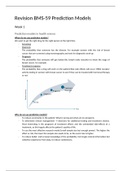Revision BMS-59 Predicton Models
Week 1
Predicton models in health science
When do we use predicton models?
We want to get the right drug for the right person at the right tme
- Screening
- Diagnosis
The probability that someone has the disease: For example women with the risk of breast
cancer that are screened using mammography and sent for diagnostc work-up
- Prognosis
The probability that someone will get beterrdie: lymph node resecton to know the stage of
breast cancer, for example.
- Treatment response
The probability that a drug will work on the patentrthat side efects will occur: HER2 receptor
actvity testng in women with breast cancer to see if they can be treated with hormonal therapy
or not
Why do we use predicton models?
- To reduce uncertainty in the patent: What is wrong and what are my prospects
- To determine clinical management → decisions for additonal testng and treatment choices.
Most interestng is the prognosis of treatment efects and the unintended side-efects of a
treatment, as this hugely afects the patentts uality of life.
- To use the most efectve research model (small sample size but enough power). The higher the
efect or risk, the lower the sample size needs to be, as the event rate is higher.
- To reduce belief, and increase knowledge of the probability. Not single centred informaton but
collectve experience from data, to reduce randomness
, Sadly, the uality of predicton studies is ofen suboptmal, especially regarding the measurement of the
predictors, and the statstcal analysisrpresentaton of the model.
The most important shortcomings are
- Too low sample size → risk of overfing
- Inappropriate handling of missing data
- Measures not reported (predicton tme frame, performance measures, calibraton)
- No internal validaton
- No informaton on how to use in practce
The perfect predicton model to use in clinical practce is cheap, easy, small (litle variables), precize,
includes tme and interactons, and is widely applicable.
Other feldss: Machine learnin
The method of predicton in medicine is very similar to methods used in biostatstcs, data science,
bioinformatcs and artfcial intelligence, where they ofen use deep learning strategies. However, the
deep learning or machine learning is for bigger datasets, broader hypotheses, and uses more advanced
data, like images or natural language.
Future directonss: Bi Data
In the future, more nano-technology and self-measuring techni ues will be introduced in healthcare,
giving a lot of new medical data that is very high throughput. This will cause a shif into the predicton
models, as we will have to learn how to deal with this Big Data.
Etologic vs. Predicton
In etology, the causal relatonship between a variable and the outcome is determined. In predicton, the
causal relatonship of the variable is not interestngg the predicton of outcome when the variable is
added to the complete model is. In predicton it is about the collectve efect of all the predictors
together, without a specifc risk factor”.
In both studies a multvariate regression analysis is used to look at the relatonship between the
variables and the outcome measure. However, in predicton research, we do not look at the OR of the
variables, but at the overall predictve performance of the model. The outcome of a predicton study is
thus not ORrRR numbers, but the probability of having the disease outcome. Also, where in etologic
research the variables are chosen by their p-value, and only the signifcant variables are included, in
predicton research a full-model approach (where all variables are included) is ofen the preferred
method, as this will give the most complete” predicton. Confounding is not an issue in predictve
studies, as it is about the overall efect, not the variables themselves.





